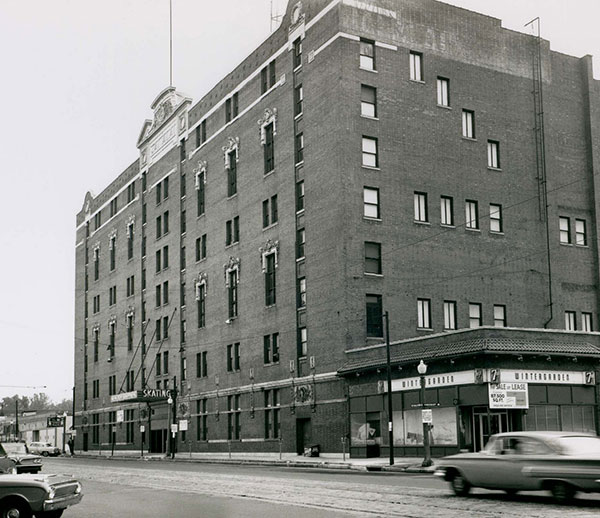Figure Skating in St. Louis – After 90 Years, “Meet Me In St. Louis”
By Susan Brownell
Although figure skating has a 90-year history in St. Louis and the city has produced many champions, 2006 marks the first time the city has hosted the U.S. Figure Skating Championships. After nearly a century, the 2006 State Farm U.S. Figure Skating Championships finally arrived. So “Meet Me in St. Louis” and let us show off what a great skating city St. Louis is.
Figure skating in St. Louis got its first boost in 1916 when a building that had been erected for the 1904 World’s Fair for the Cuban game of Jai Alai was purchased by the Winter Garden and Ice Co. and converted to an ice skating rink. Located on DeBaliviere between Delmar and Forest Park, it was used for skating in the winter; in the summer, the plant made ice for sale. For 57 years it was a center of St. Louis social life until it was demolished in 1964 to make way for a strip mall. St. Louis “society” skated there, including Gaston DuBois, the founder of Monsanto; the Forshaws, Ben Wells (7-Up), and Walter Powell. Figure skating was social – in addition to skating, they met at people’s homes and restaurants for meals together. Shirley Reflow Sherman says, “The Winter Garden was more than a skating rink. It was a center for social life of people of all ages.” On the weekends it attracted crowds of 1,000-1,400 skaters.
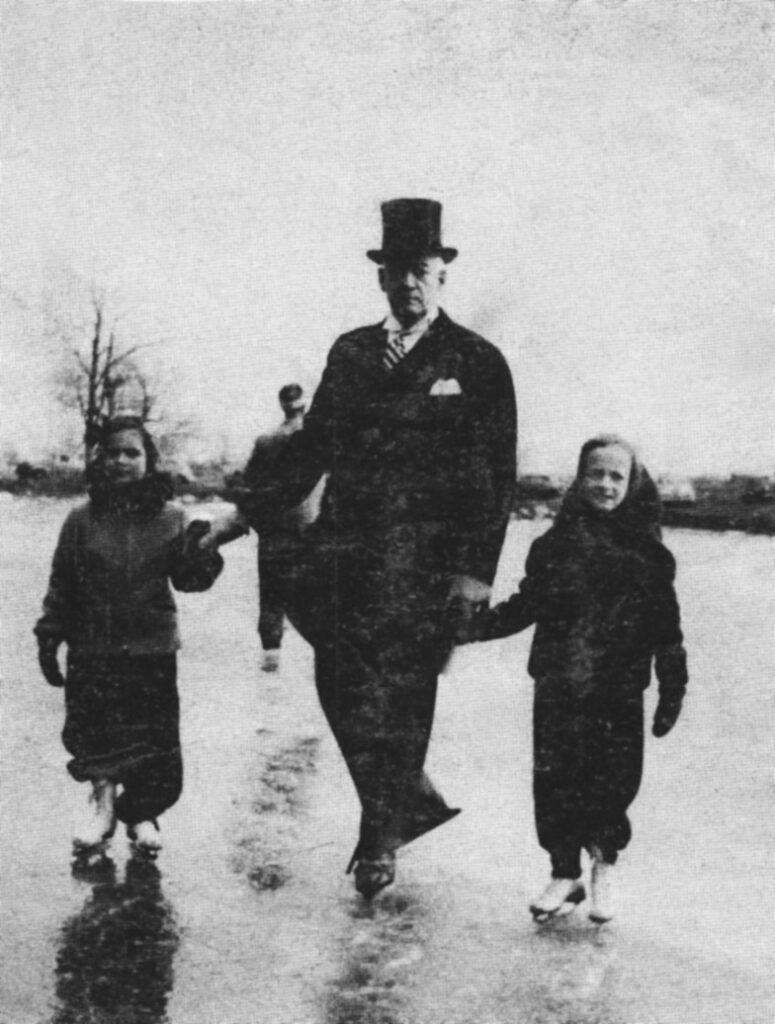
1945 – Joseph Forshaw skating in Forest Park with his granddaughters, Nancy Sauer and Anne Stocke.
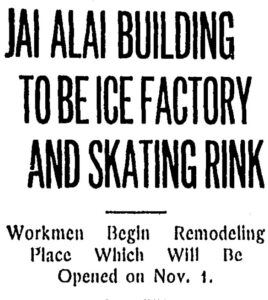
St. Louis Post-Dispatch, 1916
The ice was prepared with a scraper consisting of two I-beams pulled by a tractor. Hot water dripped out of a 55-gallon steel drum with a spigot onto a canvas, which was pushed by hand. The ice took one hour to dry, but it was perfect. Local gold judge Bill Boeck, who celebrated 42 years of judging in November 2005, recalls, “The ice surface there was absolutely like glass…To this day, it is the best ice I have ever skated on.” There was a live organ. Bob Brightfield recalls, “Live organ music was what made everyone get enthused.” “Moonlight” was a favorite feature of the Winter Garden when the lights were dimmed and overhead above the center of the rink was a sparkly moon. Bob Brightfield recalls that he was so shy that he would venture into the middle of the Winter Garden only when the lights were down for “moonlight.” Each club session ended when everyone did “shoot the ducks” in a row with their hands on the waist of the person in front of us. Shirley Sherman recalls, “Usually we all landed on the ice laughing!” She sums up the Winter Garden by saying, “It was a beautiful place.”
St. Louis’s first figure skating club was formed shortly after the ice rink was opened at the Winter Garden, led by “skating men about town” Erwin P. Hilts and William R. Cady, who recruited the charter members from among the “persons of fortunate circumstances” in St. Louis, including names still found on St. Louis landmarks, such as Mallinckrodt, and people living at addresses in exclusive locations such as Hortense Place and Kingsbury Boulevard. The club invited the professional George Muller and his sister Elsbeth to visit during the skating seasons from 1917-1919. George was a Berliner who had performed before heads of state in Sweden and Canada, while Elsbeth had been a pioneer in introducing “fancy skating” to German women. In 1912 Muller had been invited by the Boston Skating Club to introduce the international style of figure skating in America. He was affiliated with several American clubs and is today remembered as the inventor of the Dutch Waltz, Fiesta Tango, Willow Waltz, and Ten Fox dances. Membership in St. Louis’s first figure skating club reached 350 in its heights, but it went into a decline in the 1920s after World War I.
The next key turning point in St. Louis’s history came in 1928. Earl Reflow was born into a poor family in rural Colorado in 1893. At age 14, he ran away from home to San Francisco, where he took up professional boxing to make some money, and then stowed away on a ship to Australia. He boxed in Australia and New Zealand and then in Kansas City, where he joined a traveling vaudeville show. He came to St. Louis in 1918 and ran small hotels. He was a man who was far ahead of his time, one of the first sports promoters in the U.S. Seeing the possibilities in ice sports, he leased the Winter Garden in 1928 and started professional hockey in St. Louis by organizing the Flyers in 1929. In 1930 he enlarged the ice surface to 220 by 112 ft., which he claimed made it the largest indoor ice rink in the world.
In addition, the St. Louis Arena was built in 1930, with an ice surface of 108 ft. by 265 ft. and a capacity of 15 to 20,000 spectators. The Arena was also the site of the 1994 Olympic Festival where Tara Lipinski burst onto the national scene. To the chagrin of nostalgic sports fans, it was demolished in 1999.
In 1930 the figure skating club was revived and registered with the USFSA as the St. Louis Skating Club, making it the third-oldest USFSA club west of the Mississippi (after the Chicago Figure Skating Club and the Twin City Figure Skating Club, later the Figure Skating Club of Minneapolis, which were two of the charter member clubs of the USFSA in 1921). Within a year it had 100 members, ranging from grandparents to 5 year-old Shirley Reflow, the youngest daughter of Earl. George Muller and his wife Leah returned to St. Louis, and George observed to the Globe Democrat, that the rapid increase in membership indicated “St. Louisans are genuinely interested in ice skating. We anticipate developing skaters of sufficient skill to enter the national championships… The ideal situation would be for enough persons to become sufficiently interested to warrant the holding of a Middle Western championship match.” His vision was realized at the Winter Garden in 1933 when St. Louis became the site of the Mid-Western Figure Skating Championships – according to the March 1933 Skating magazine, the first-ever inter-state contest of its kind in the U.S. Skaters came with their friends and family from Minneapolis, Duluth, Chicago, Kansas City, and Des Moines.
St. Louis’s next goal was to train national champions, but even in the 1930s this required money. A 1935 newspaper article noted that the high expense was an obstacle to aspiring stars, with properly fitting skates costing as much as $50 or $60! “With the hope of putting St. Louis on the figure skating map,” the St. Louis Skating Club held its first Figure Skating Carnival on March 27-28, 1935, at the Winter Garden. Entitled, “Winter Olympic Ice Follies,” it featured figure skating exhibitions, speed skating, and a hockey game.
In addition to raising funds with carnivals, the more affluent members of the skating club funded the training of talented skaters. The pillar of the skating community was Walter Powell, Vice President of the Brown Shoe Company. He sponsored many skaters who didn’t know it. One of them was Red Knoll, who with his wife Sally Haas Knoll was a coach and mainstay in the St. Louis skating community up to the present. Red’s passing in 2005 was deeply felt by the skating community. Red thought he was receiving free lessons from his coaches until Powell’s wife told him after Powell’s death that his coaches had been paid by Powell. Sally Knoll said that no one called him “Walter” – it was “Mr. Powell.” “He seemed like he was very strict and proper but he was really a pussycat.” Helen Nightingale recalls him as “a quiet, nice man who never said a cross word.” Marge Brightfield joked that although he was a judge, “We would do a dance and he didn’t know the steps – how he judged I don’t know. It was political back then.”
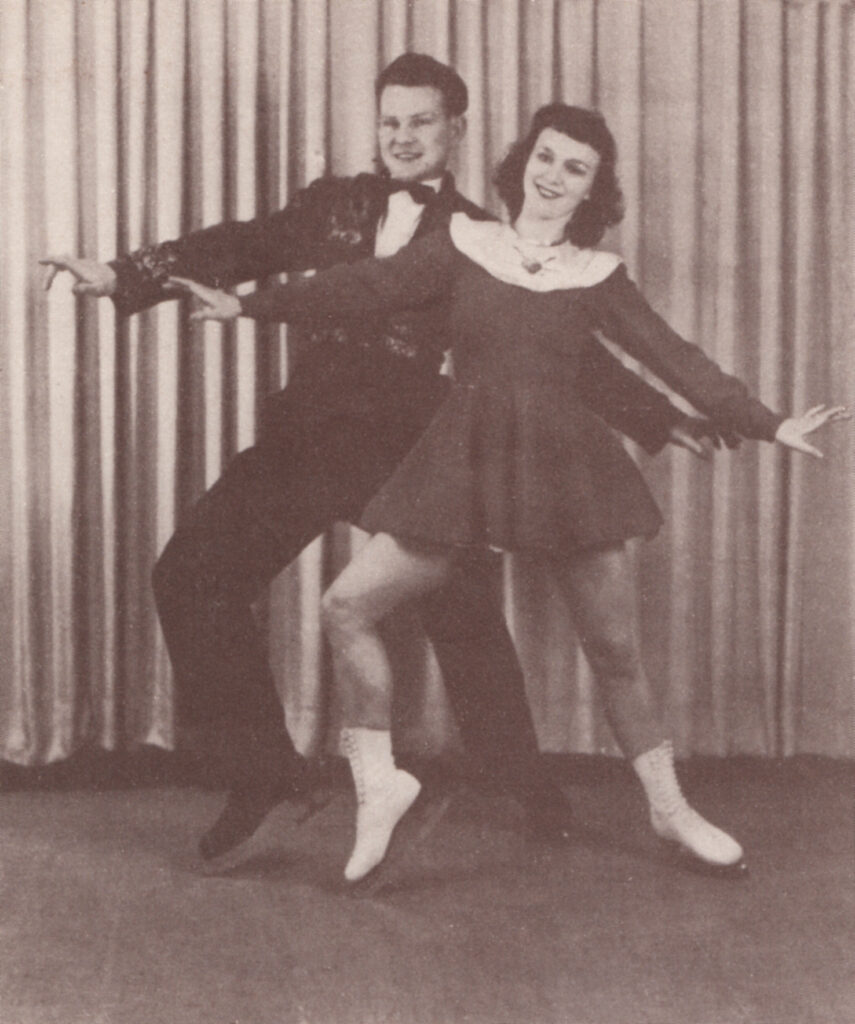
Red and Sally Knoll
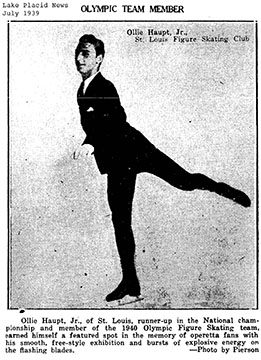
Powell made possible the achievements of Ollie Haupt, Jr., who today still ranks as the most successful figure skater to represent a local skating club. Ollie did not come from money. His father and mother were divorced and his father ran a Ford agency. He lived with his mother close to the rink. Powell sent him to New York for lessons from the top pro, Karl Schafer. Representing the St. Louis Skating Club, he was Novice Men’s National champion in 1934, and Junior Pairs National Champion with Jeanne Schulte in 1935. He was Junior Men’s National Champion in 1937, then won bronze in Senior Men in 1938 and silver in 1939 and 1940. Although this qualified him to compete in the World Championships, his name is not on the list of participants – perhaps because in those days skaters had to pay their own and their coach’s expenses, and so often only the gold medallists considered it worthwhile. One of St. Louis’s sadly missed opportunities was when Haupt became the only representative of a local St. Louis club to ever make an Olympic team, but the Olympic Games were cancelled. He was on the 1940 team when the Olympics were cancelled due to World War II.
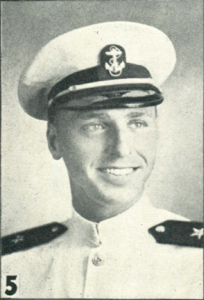
Ollie was an inspiration to many local skaters. Bob Brightfield, who at 86 is today “the oldest skater in St. Louis,” recalls that Ollie had a sweater with the five Olympic rings on it, and Bob says, “I was so impressed.” Bob remembers that Ollie could do two bunny hops and a waltz jump that nearly took him the length of the rink. When Ollie was drafted during World War II in 1942, eight of them went to Union Station to see him off. Ollie’s mother handed him a fifth of whiskey as he was getting onto the train.
Other St. Louis skaters won national medals in the 1930s, too. Ruth English and Len Fogassey won the bronze in the Original Dance at the 1934 U.S. Nationals. In 1935 Ruth Banks, Ruth English, W.R. Cady, and Len Fogassey won the bronze medal in Fours. Ruth English would later take over managing the Winter Garden in the 1940s after Earl Reflow’s death.
On April 7, 1936, Earl Reflow chaired the organizing committee for an “International Skating Carnival” at the Arena featuring Sonja Henie, who had just turned pro after winning her three consecutive Olympic gold medals (1928, 32, 36). She performed several times, including the routine that won the Olympic title in Garmisch-Partenkirchen. Jack Dunn, English champion and silver medal in the Olympics, also appeared.
In the days when the only female athletic starts were figure skaters and tennis players, Sonja Henie was an inspiration for the first generation of female skaters in St. Louis. One of them was Helen Nightingale, the most accomplished female skater from the St. Louis Skating Club, who recalls, “Nobody knew what skating was until they saw her in ‘The Picture Show.’ She was the original godmother of all skating.” She performed several times in St. Louis.
Earl Reflow’s two daughters, Elizabeth and Shirley, who was then nine, performed in the 1936 Carnival along with Sonja. A USFSA rule excluding rink managers and their families from skating clubs made it impossible to be the daughter of a rink manager and compete, but Shirley became known as an outstanding amateur show performer and was often a guest at club shows throughout the Midwest, which was unusual at that time. Some of her programs were considered risqué in their day, such as “A Persian Fantasy” in the St. Louis Skating Club’s 1944 Victory Ice Revue, which featured a costume with a bare midriff, but she remembers, “I was the most shy and scared – I never dated anyone.” In 1955 she left St. Louis for Chicago when her husband was transferred. Her married name is Shirley Sherman, and today she is a national-level judge in singles/pairs and dance who has judged eleven senior nationals since 1979. Her sister, Elizabeth Binder, still lives in St. Louis.
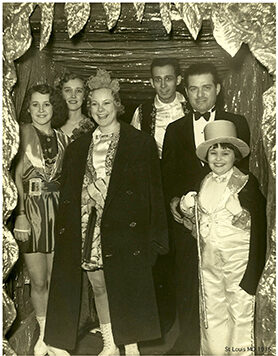
St. Louis April 7, 1936 – L to R: Dorothy Lewis, Josephene Fogassey, Sonja Henie, Len Fogassey, Sam Lewis (father of barrel jumper Buddy), Shirley Reflow.
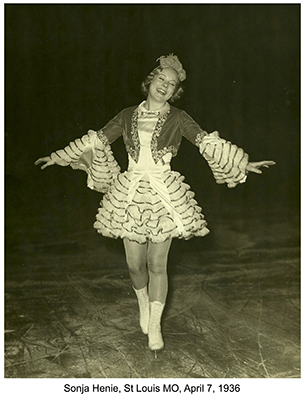
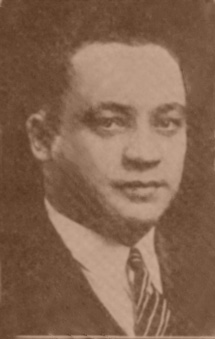
Earl Reflow
Earl Reflow died in 1944 at the young age of 51. The “Ice Skating News” of the Winter Garden published a tribute that noted, “Ice skating was more than a business to him. It was the creation of a new art and the promotion of a clean sport. To that end he worked with tireless devotion…he was a good man, kindly of heart and noble in character…” Unfortunately for figure skating in St. Louis, he was not around to see the huge changes in the sport wrought by television in the 1960s. We can only wonder whether the history of skating in St. Louis would have been different if he had lived long enough to take advantage of the new business opportunities.
St. Louis skaters continued to have success throughout the 1940s, although they were always hampered by the fact that there was no year-round rink in the city and so they had to go elsewhere to train from March to May, a situation that did not change until the 1970s. As a result, many of the best skaters moved away and represented other clubs, a trend that continues to today. Carole Gregory skated for the All-Year Mercury Figure Skating Club in California and competed in U.S. Nationals as a Junior in 1946 and a senior in 1947. Her married name became Krummenacher and she later became the mother-in-law of NBC sports anchorman and St. Louis resident Bob Costas. Jane Zeiser qualified for Senior Nationals and then turned pro and skated in Ice Follies in 1945 and 1946. Joan Newhall Swanston represented the St. Louis Skating Club in the 1945 and 1946 Nationals as a Junior Lady, placing third in 1945. Jack Jost moved to Baltimore and won Junior Pairs and Junior Dance at the 1951 nationals.
Helen Geekie is the most accomplished female skater to represent a local skating club. She started skating in Saturday classes at the Winter Garden after seeing Sonja Henie movies. She represented the St. Louis Skating Club, but in the summers and during holidays she trained in Lake Placid, Colorado Springs, Denver, and Cleveland. Before the 1952 Olympic Trials she trained with Eugene Turner and roomed with another of his skaters, the legend Tenley Albright. She skated in eight U.S. nationals from the Novice to Senior levels from 1945 to 1952, placing fourth in Novice (1945) and Junior (1946), sixth or seventh in the 1948 Olympic Trials, and third in the 1952 nationals as a Senior Lady. In another of St. Louis’s near misses, she placed fourth in the 1952 Olympic Trials, missing the Olympic team by one spot. Her nationals third place qualified her for the 1952 World Championships, but in those days only Olympic teams had their way paid to competitions, and her parents decided it was not worth the expense of paying her way, and that of her coach, to Worlds since she had only placed fourth in the Olympic Trials. She was the ballerina whose forte was her artistry; she trained with the top dancers from the Muny under instructors from the Ballet Russe in Monte Carlo. She did double jumps through the flip, split jumps, spread eagles, flying camels, and camel spins. She observes that the difference between then and now is that in the days before television changed everything, they were true amateurs who skated “for the love of the sport.”
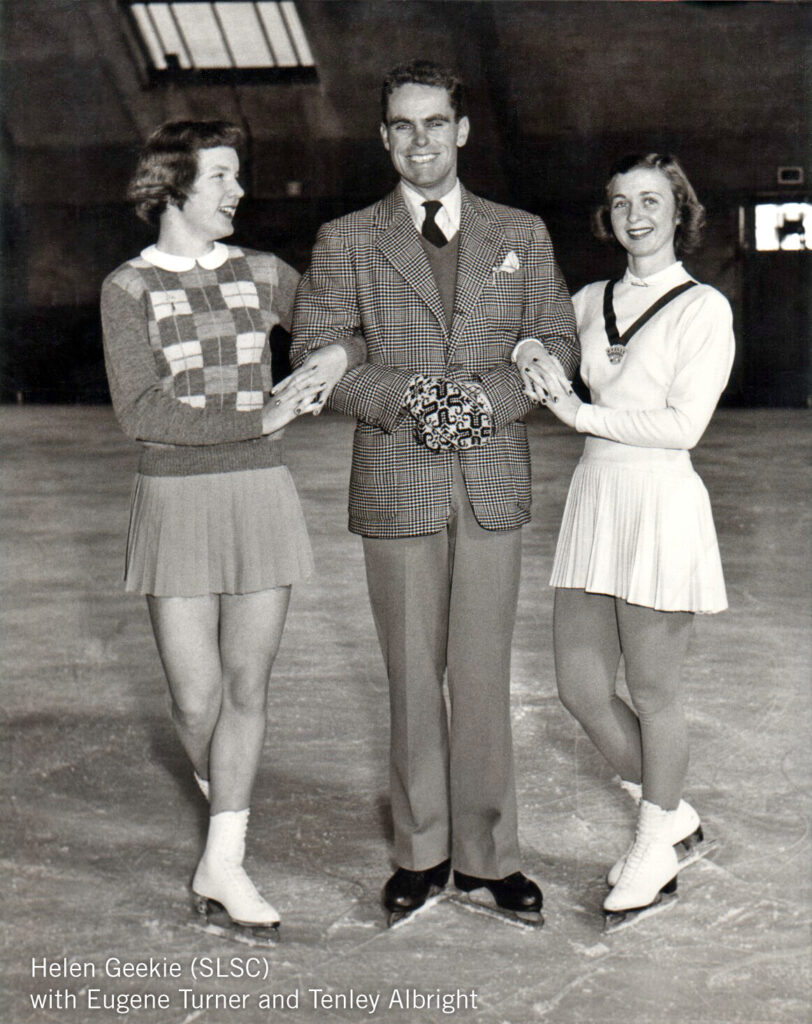
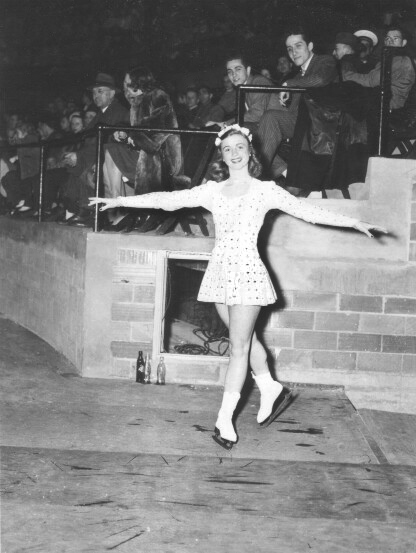
Helen met John Nightingale at Midwestern sectionals and they became a couple in 1950, then got married in 1952. John, who was from St. Paul, had competed as a Novice Man in the 1946 nationals and in Junior Pairs. He also was a member of the team that won the gold medal in Fours in 1947, 1948, and 1950. He was the Junior Pairs champion with Janet Gerhauser in 1950, and they won silver at the Senior level at 1951 and 1952 Nationals, placing eighth at 1951 Worlds. They placed sixth in the 1952 Olympics in Oslo, Norway. When John retired from the military in 1974 he and Helen returned to St. Louis and started coaching. Helen has been coaching group lessons at the Creve Coeur ice rink ever since. They have mentored many of the top skaters in St. Louis for the Creve Coeur Figure Skating Club since the 1970s.
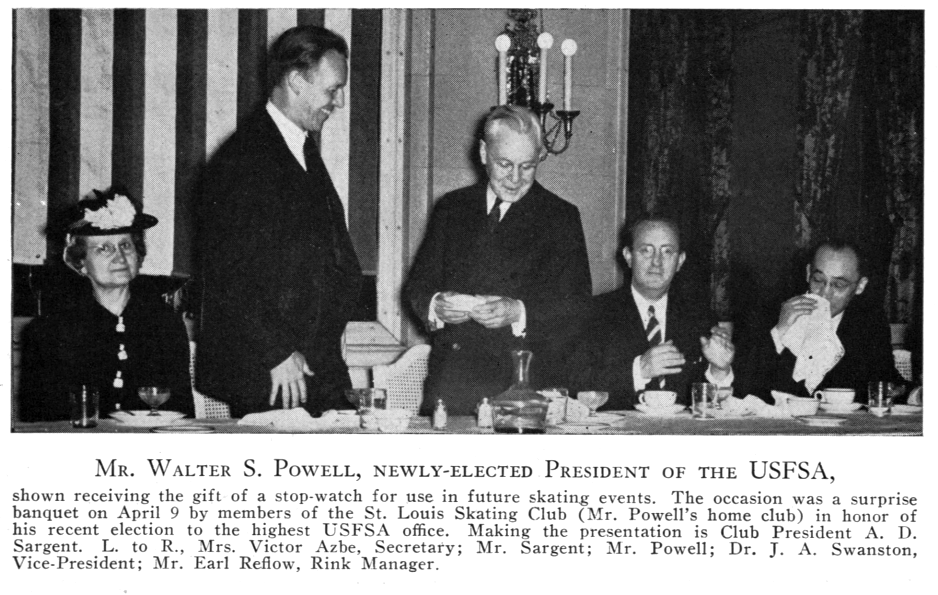
During the 1940s, Walter Powell met Helen Lamb through figure skating and they often skated together at the Winter Garden. They also shared a passion for the symphony. Helen was a nationally-known nurse anesthetist at Barnes Hospital who was instrumental in the founding of the American Association of Nurse Anesthetists. She became his second wife in 1951, when she was 61 and he was 72. Powell’s influence in the skating world expanded to the national and international levels as he was a referee at the 1952 Olympic Winter Games in Oslo, Norway, and the 1960 Games in Squaw Valley, California. On February 14, 1961, Powell was on the fateful plane going to the World Championships in Belgium, where he was to be a referee. He was secretary of the U.S. Olympic Figure Skating Committee and had been made an honorary member of the USFSA in 1960. He died when the Sabena Airlines jet went down in a field near the Brussels airport, killing everyone on board, including the entire 18-member U.S. team and 13 others who were accompanying them. His estate was reported to be valued at over $1 million. In 1966, Lamb made the Saint Louis Symphony Society beneficiary of a $1 million charitable trust to be given on her death. The Symphony bought the St. Louis Theater built in 1925 and renovated it. Today we know it as Powell Symphony Hall. A newspaper article at the time observed that although neither Lamb or Powell could sing a tune, nor were they musically talented, both could ice dance very well. Many members of the skating community felt that Walter might have preferred that his money went to the sport he loved. Certainly his death was a blow to skating in St. Louis.

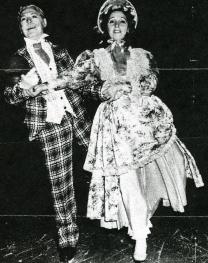
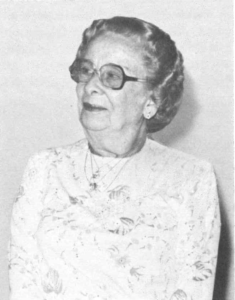
Helen Lamb
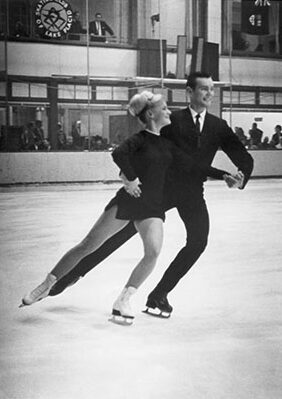
Figure skating went into a decline and St. Louis did not produce any standouts in the sport from the mid 1950s until the 1980s. Meanwhile, Dennis Sveum, representing the Los Angeles Figure Skating Club, was U.S. national dance champion in 1965 and 1966 with Kristin Fortune. They won the silver medal at the 1966 World Dance Championships in Davos, Switzerland, which today still equals the highest finish by any U.S. dance team in a world competition (in 2005 Tanith Belbin and Benjamin Agosto became the sixth U.S. dance team to win a silver medal at worlds). In 1983 Dennis moved to St. Louis, where he has been a professional coach, judge, referee, and holder of multiple offices in the St. Louis Skating Club. He has been a U.S. national judge in dance since 1998 and is a Regional referee. As President of the Heartland Inter-Club Association and a member of the Executive Board of the St. Louis 2006 Organizing Committee, he was instrumental in bringing the 2006 Nationals to St. Louis and in making them happen.
Among those skaters with local roots who moved elsewhere to develop their skating careers, Lea Ann Miller stands out. She started skating at the age of eight when the Kirkwood rink opened near her home (today her parents still live in the St. Louis area). She moved to Colorado to train before starting high school, where she paired up with Bill Fauver. Lea Ann fractured vertebra in her back in a skiing accident eight months before the 1980 U.S. Nationals, but they were still able to make the 1980 Olympic Team. They moved to Delaware to train with Rod Ludington and eventually won silver in Senior Pairs at U.S. Nationals in 1981, 1983, and 1984, and bronze in 1982. They placed tenth at the 1984 Olympic Games in Sarajevo, Yugoslavia. They then turned professional and toured with John Curry’s theater and with Torvill and Dean. After placing second in the 1986 world professional championships in Landover, MD, they were invited to tour with Stars on Ice. During their sixyear stint, Lea Ann started to try her hand at choreography and when she retired in 1994 she became the Performance Director for Stars on Ice. Today she is one of the most sought-after choreographers in the world, and has choreographed programs for world champions including Shen Xue and Zhao Hongbo, Tara Lipinski, Yuka Sato, and many others. Lea Ann made appearances in St. Louis to promote the 2006 nationals, stating that she hoped skating in St. Louis would develop so that young skaters no longer have to move away in order to realize their potential.
From the 1980s to today there have been several other local skaters who have attained national prominence. Maradith Feinberg left her family in Olivette at age eleven to train with coaches across the country, from Colorado Springs to Philadelphia, Atlanta and Cleveland. She competed in Senior Ladies at the 1983, 1984, 1985 nationals, placing 9 th in 1984, and representing the U.S. in international competitions. She was also sixth in Pairs at 1986 Nationals with Craig Maurizi. In 1988 she turned pro, skated with Disney’s World on Ice – Beauty and the Beast, among others.
Sarah Booth and Matt Buttrey competed at the national level without leaving their homes in Cape Girardeau, Missouri, placing 6th in 1993 Novice Nationals in pairs, 5 th in 1994 Olympic Festival, and 12 th in Junior Pairs at 1995 nationals.
Kelsey Drewel, a native of Troy, Missouri, won the 2001 Novice Nationals while training at the University of Delaware, returned to Troy two years later and represented the St. Louis Skating Club as a Senior Lady at 2003 Nationals, making her the first skater resident and training in the St. Louis area to compete internationally (Triglav Trophy 2001, Vienna Cup 2002) and qualify for senior level nationals since Helen Geekie in 1952, a gap of 51 years.
Brandon Mroz was a four-time consecutive Upper Great Lakes Regionals champion at Juvenile, Intermediate, and Novice, 2002-2005. He placed seventh in Novice Men at 2004 U.S. Nationals when he was only 13.
Mauri Gustafson moved to Dallas from St. Louis and paired up with Logan Giulietti-Schmitt. They competed at the 2005 U.S. Championships in Junior Dance.
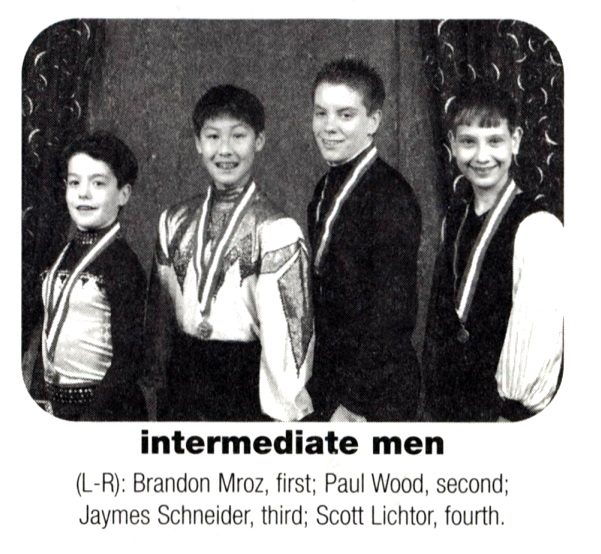
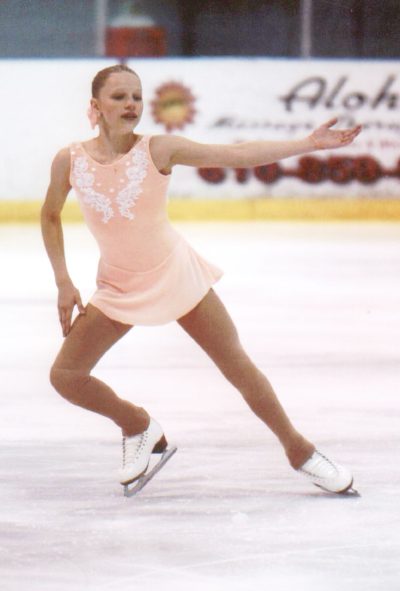
At the 2006 U.S.Championships, St. Louis is represented by three local skaters: Brandon in Novice Men, Mauri in Junior Dance and Debbie Knubley in Novice Ladies. Representing the St. Louis Skating Club, Debbie is the only skater at the competition to represent a St. Louis area club.
Today the Heartland Inter-Club boasts seven member clubs with a total membership of about 650: the Creve Coeur Figure Skating Club, Diamond Ice Figure Skating Club, Jefferson City Figure Skating Club, Metro Edge Figure Skating Club, Show Me Blades Skating Club, St. Peters Figure Skating Association, and the St. Louis Skating Club.
Throughout all of those years, one of the mainstays of the skating community has been Bob Brightfield and his wife, Marge, who at 86 and 81 respectively, call themselves “the oldest skaters in St. Louis.” Both are St. Louis natives, born and raised. Bob started skating at the Winter Garden in the late thirties, when he was around twenty. He says he got into the St. Louis Skating Club although he was not a member of “society” because there was a shortage of men. On dance weekends, the men had to dance two times for each one time a woman danced. Before Marge took up ice skating, she roller skated and once placed fourth in Intermediate Ladies at the roller skating nationals. They were married in 1950 and celebrated their 55-year anniversary on November 18. Except for ten years when they were busy raising kids, they have been skating for nearly seventy years now. Marge tested through her silver dances and now, at the age of 81, is going to work on her pre-golds. She teaches learn-to-skate at Creve Coeur and can still do a waltz jump. They have been recreational skaters for all those years, simply because, as Bob puts it, “I get a thrill out of just stroking out, moving out across the ice.” Marge adds, “It’s great fun when the music plays. There’s a connection between the music and the skating.”
The author would like to express thanks to Shirley Reflow Sherman, who provided her collection of newspaper clippings for this article. In addition, Shirley Sherman, Sally Knoll, Helen Geekie Nightingale, and Marge and Bob Brightfield were interviewed by the author. Bill Boeck provided his written reminiscences.
A shorter version of this article appeared in the official program for the 2006 U.S. Championships.
